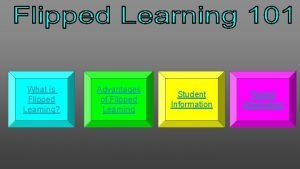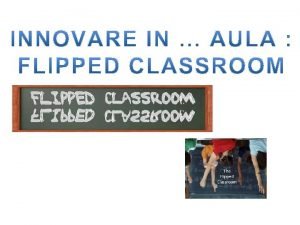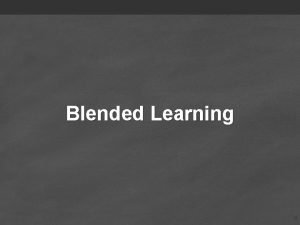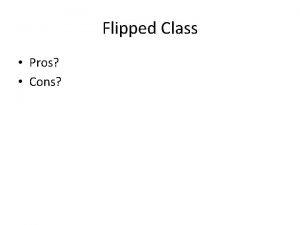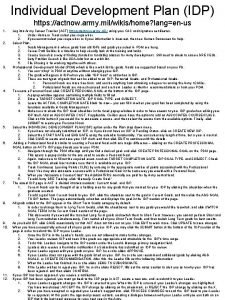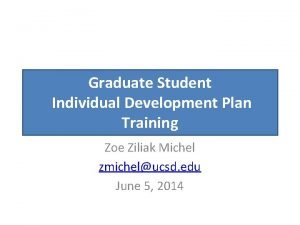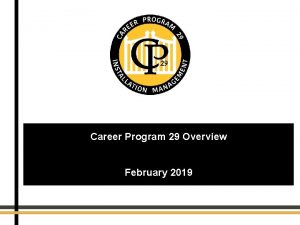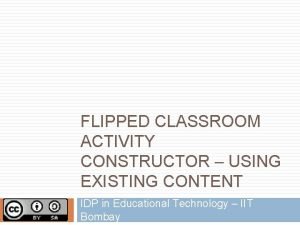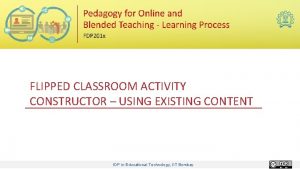FLIPPED CLASSROOM ACTIVITY CONSTRUCTOR USING EXISTING CONTENT IDP

















- Slides: 17

FLIPPED CLASSROOM ACTIVITY CONSTRUCTOR – USING EXISTING CONTENT IDP in Educational Technology, IIT Bombay

Table of Contents SECTION SLIDE # ABOUT OUT-OF-CLASS SEGMENT IN-CLASS SEGMENT EVALUATION 3 4 8 14 COMMUNITY BUILDING IDP in Educational Technology, IIT Bombay 2

Satyanarayana K FORECASTING PRODUCTION PLANNING AND CONTROL IV YEAR UG STUDENTS MECHANICAL GRIET, HYD IDP in Educational Technology, IIT Bombay 3

Out-of-class Activity Design -1 Learning Objective(s) of Out-of-Class Activity At the end of video student can • Know the types of Forecasting • Know the applications of Forecasting • Solve the problems with the help of formulae Key Concept(s) to be covered § § Types of Forecasting Formulae for problem solving. IDP in Educational Technology, IIT Bombay 4

Out-of-class Activity Design - 2 https: //www. youtube. com/watch? v=u. V 4 g 9 p 08 n. Xg https: //youtu. be/u. V 4 g 9 p 08 n. Xg? t=1248 Standard You. Tube License of Video Mapping Concept to Video Source Main Video Source URL CONCEPT VIDEO SEGMENT DURATION (in min) FORECASTING V 1 - 0: 00 – 10: 52 10. 55 Types of forecasting V 2 - 10: 55 – 20: 46 10. 15 SIMPLIFICATION V 3 - 20: 47 – 28: 25 8. 75 TOTAL DURATION 28. 2 min IDP in Educational Technology, IIT Bombay 5

Out-of-class Activity Design - 3 Aligning Assessment with Learning Objective Assessment Strategy Explain the Q. Differentiate between simple Question moving average and weighted moving average Expected Duration (in min) Additional Instructions (if any) 10 minutes Watch V 2 and then answer IDP in Educational Technology, IIT Bombay 6

Out-of-class Activity Design - 3 Aligning Assessment with Learning Objective Assessment Strategy Explain the Explain different types of concept with Qualitative and Quantitative the help of forecasting video TOTAL DURATION Expected Duration (in min) Additional Instructions (if any) 15 minutes Watch V 1 and then answer 25 min IDP in Educational Technology, IIT Bombay 7

In-class Activity Design -1 Learning Objective(s) of In-Class Activity At the end of the class, students will be able to, Solve forecasting problems involving simplification (ANALYZE Level) § Implement different types of formulae for different methods of quantitative(ANALYZE Level) § Key Concept(s) to be covered § Use of formula for Problem Solving. § Knowing the difference between qualitative and quantitative methods. IDP in Educational Technology, IIT Bombay 8

In-class Activity Design -2 Active Learning activities that I plan to do Forecasting problem solving using. § Think-Pair-Share Concept clarification using. § Peer Instruction IDP in Educational Technology, IIT Bombay 9

In-class Activity Design -2 Peer Instruction Strategy – What Teacher Does Q 2: One of the two wheeler manufacturing company experienced irregular but usually increasing demand for three products. The demand was found to be 420 bikes for June and 440 bikes for July. They use a forecasting method which takes average of past year to forecast future demand. Using the simple average method demand forecast for June is found as 320 bikes (Use a smoothing coefficient 0. 7 to weight the recent demand most heavily) and find the demand forecast for August. IDP in Educational Technology, IIT Bombay 10

In-class Activity Design -2 Peer Instruction Strategy – What Teacher Does Pose the two PI questions at the start of the class and provide summary of basic identities and expression simplification. Q 1: (a) A manufacturing company has monthly demand for one of its products as follows: Mon Feb Mar Apr May June July Aug Sept th Dem 520 and 490 550 580 600 420 510 610 Develop a three period moving average forecast IDP in Educational Technology, IIT Bombay 11

In-class Activity Design -2 Peer Instruction Strategy – What Student Does § § § For each question they will first solve individually. Then they will discuss with peers and come to consensus. Listen to instructors explanation. IDP in Educational Technology, IIT Bombay 12

In-class Activity Design -2 TPS Strategy – What Instructor does First provide a premise One of the two wheeler manufacturing company experienced irregular but usually increasing demand for three products. The demand was found to be 420 bikes for June and 440 bikes for July. They use a forecasting method which takes average of past year to forecast future demand. Using the simple average method demand forecast for June is found as 320 bikes (Use a smoothing coefficient 0. 7 to weight the recent demand most heavily) and find the demand forecast for August. It will be intimated to students Initially the demand forecasting of July should be calculated then August should be calculated IDP in Educational Technology, IIT Bombay 13

In-class Activity Design -2 TPS Strategy – What Instructor does Think (~5 minutes) Out of the quantitative methods, every individual student should think about the method to be applied IDP in Educational Technology, IIT Bombay 14

In-class Activity Design -2 TPS Strategy – What Instructor does Pair (~8 minutes) Instruction: Now pair up and compare your answers. Agree on one final answer. While students are pairing and discussing, instructor goes to 2~3 sections to see what they are doing. IDP in Educational Technology, IIT Bombay 15

In-class Activity Design -2 TPS Strategy – What Instructor does Share (~8 minutes) Instructor asks a group to share their answer with class and see whethere are different answers. After sharing is done, instructor gives feedback on the correct solution and how to solve the problem In the next iteration of TPS, in the Think Phase we ask students to calculate three period moving average for the given problem. In the pair phase we ask students to compare the answers. In the share phase again the different answers are sought. IDP in Educational Technology, IIT Bombay 16

In-class Activity Design -2 Justify why the above is an active learning strategy In both the above strategies, students are required to go beyond mere listening and execution of prescribed steps. They are required to think deeply about the content they were familiarized in out-of-class and do higher order thinking. There is also feedback provided (either through peer discussion or instructor summary) IDP in Educational Technology, IIT Bombay 17
 Paola seregni
Paola seregni Flipped classroom advantages and disadvantages
Flipped classroom advantages and disadvantages Venitemi dietro con l'occhio
Venitemi dietro con l'occhio Moodle beal
Moodle beal Didattica capovolta
Didattica capovolta Bioengineering flipped classroom
Bioengineering flipped classroom Flipped classroom
Flipped classroom Flipped classroom model
Flipped classroom model Flipped classroom pros and cons
Flipped classroom pros and cons Army actnow
Army actnow Idp examples
Idp examples Army setm
Army setm How to collect rsi logs in juniper
How to collect rsi logs in juniper Bosch bcc100 troubleshooting
Bosch bcc100 troubleshooting Glipmpse
Glipmpse Idp project
Idp project Idp vsko
Idp vsko Idp vendor landscape
Idp vendor landscape

